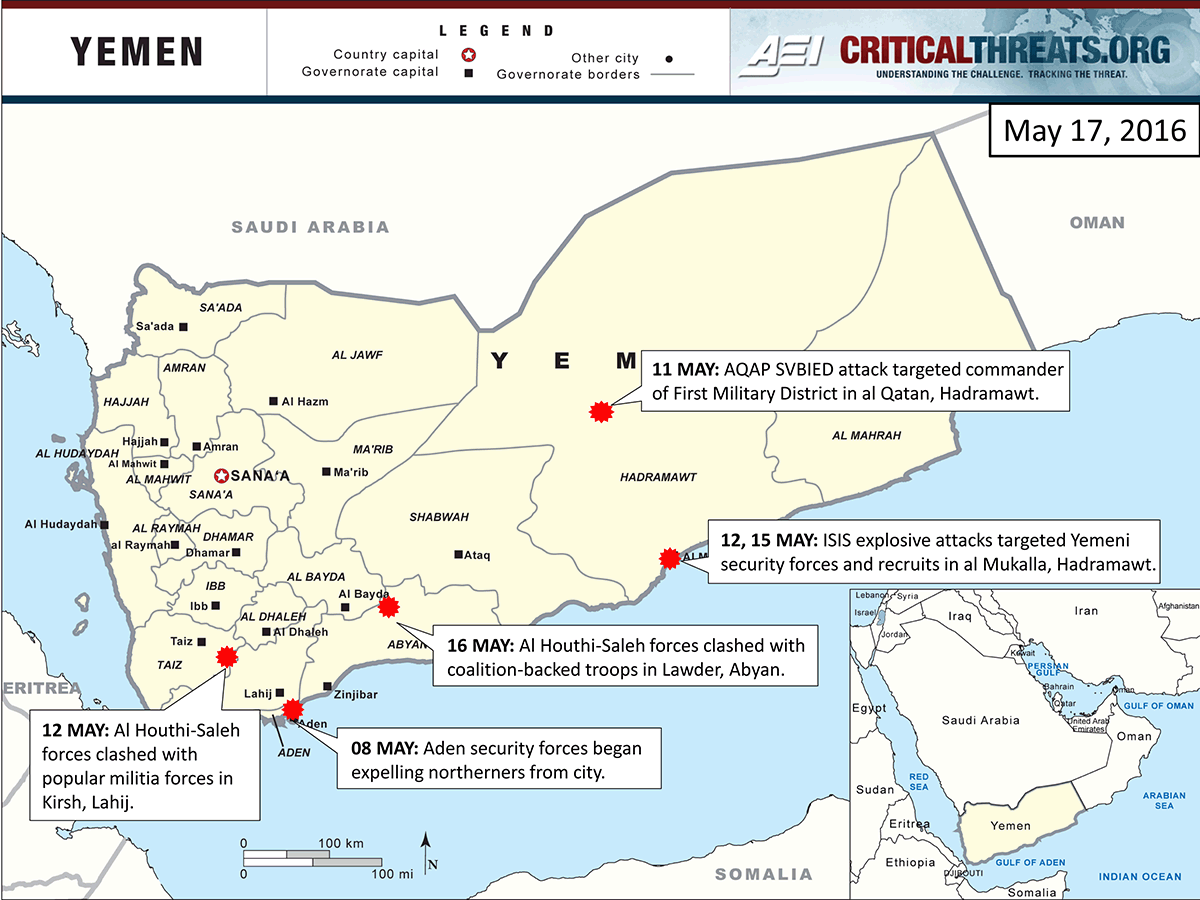ISIS Wilayat Hadramawt began an explosives attack campaign against Yemeni security forces and new recruits in al Mukalla, Hadramawt. ISIS Wilayat Aden-Abyan is prosecuting a similar campaign in Aden, launched in October 2015. ISIS Wilayat Hadramawt claimed credit for a suicide vehicle-borne improvised explosive device (VBIED) attack near a naval base outside of on May 12. It also claimed credit for the suicide attack targeting security force recruits in al Mukalla on May 15, framing the May 15 attack as part of a global campaign, the “Invasion of Sheikh Abu Ali al Anbari.” Two additional VBIEDs were found and cleared in al Mukalla on May 13, which may have been pre-positioned for additional attacks. It is not clear whether ISIS will be able to sustain the tempo of attacks in the area. ISIS Wilayat Hadramawt likely has sanctuary in Wadi Hadramawt and may have deployed attack cells to al Mukalla. [ISIS statements translated by SITE.]
Al Qaeda in the Arabian Peninsula (AQAP) preserved its force strength and capabilities by withdrawing from territory in Abyan and Hadramawt. AQAP senior leader Khaled Batarfi warned that the group would fight on its terms and claimed two attempted assassinations of high-ranking Yemeni officials in Aden and Hadramawt. Batarfi accused the United States of imposing a “new reality” in Yemen, likely a reference to the ongoing international pressure on a negotiated settlement to Yemen’s civil war. AQAP statements continue to criticize the Emirati role in the counter-AQAP offensive and warn of a “Houthified” future Yemeni state. [Statements translated by SITE.] The group just released an issue of its English-language Inspire magazine, which speaks to a Western audience, and its weekly Arabic-language newspaper, al Masra, which focuses on the global jihadist movement.
The U.S. and members of the Saudi-led coalition are pressuring the Hadi government to participate in the UN-led Kuwait talks in good faith. The delegations have not made significant progress in the peace talks. It is likely that the establishment of issue-focused committees was an effort to negotiate tactical issues, such as prisoner exchanges, within the Kuwait framework. U.S. President Barack Obama cited the actions and policies of certain members of Hadi’s government as threatening Yemen’s peace and security, and Saudi Foreign Minister Adel al Jubeir signaled a reversal in Saudi priorities in Yemen, emphasizing the fight against al Qaeda and ISIS and expressing openness to negotiation with the al Houthis on May 12. Saudi officials may also be opening additional back channels as reports of al Houthi-Saudi direct talks continue and coalition commanders Saudi Deputy Crown Prince Mohammed bin Salman and Crown Prince of Abu Dhabi Mohammed bin Zayed al Nahyan held unofficial meetings in Riyadh with former Yemeni Vice President and Prime Minister Khaled Bahah, a consensus candidate broadly favored to lead a possible transitional government.
Clashes continue along established frontlines with minor advances by al Houthi-Saleh forces on the southern front and pro-government gains in central Taiz city. Al Houthi-Saleh forces may be exerting pressure on the Hadi government’s nominal control of southern Yemen as fissures continue to weaken the Hadi alliance. Al Houthi-Saleh forces moved into northwestern Lahij governorate from positions in al Wazi’iyah district in southern Taiz, and clashes flared in Kirsh in northern Lahij. Government and local popular resistance forces clashed with al Houthi-Saleh forces in Lawder on the al Bayda-Abyan border for the first time since August 2015, while clashes continue in central al Bayda itself. AQAP supports the anti-al Houthi fight in al Bayda and had participated in the fight to drive al Houthi-Saleh forces from Abyan. The group may use this setback as evidence to support its narrative that the coalition’s actions are assisting the al Houthis. Al Houthi-Saleh forces continue to contest the peripheries of Taiz city, though government and popular resistance forces appear to have consolidated control of the city’s center. Fighting continues in central and western Ma’rib, in Nihm district northwest of Sana’a, and sporadically in parts of southwestern al Jawf and northwestern Shabwah.
Southern Yemeni leaders within Hadi’s government may enjoy a level of autonomy in pursuing lines of effort that serve the Southern Movement’s interest. Aden police and security forces cracked down on alleged violations of Aden’s residency laws, arresting and deporting hundreds of northern Yemeni immigrants. President Hadi and Prime Minister Ahmed Obaid bin Daghr called for Aden Governor Aydarus al Zubaidi and security chief Shalal Ali Shaye’a to exert control over their forces, but deportations continued. Governor Zubaidi expressed support for the operation, noting it was to crack down on terrorism and crime. Al Zubaidi began a series of weekly Wednesday meetings with individuals from different sectors of Adeni society to discuss their concerns. The governor’s actions coincide with water and electricity shortages in Aden.
Al Houthi-Saleh ground advances will likely feed AQAP’s narrative that the coalition-backed forces and international community is seeking a “Houthified” Yemen, which could drive support to the group. Both ISIS and AQAP attacks have the potential to disrupt the coalition and Hadi government’s progress in re-establishing stability in southern and eastern Yemen.
← PREVIOUS |
NEXT → |

